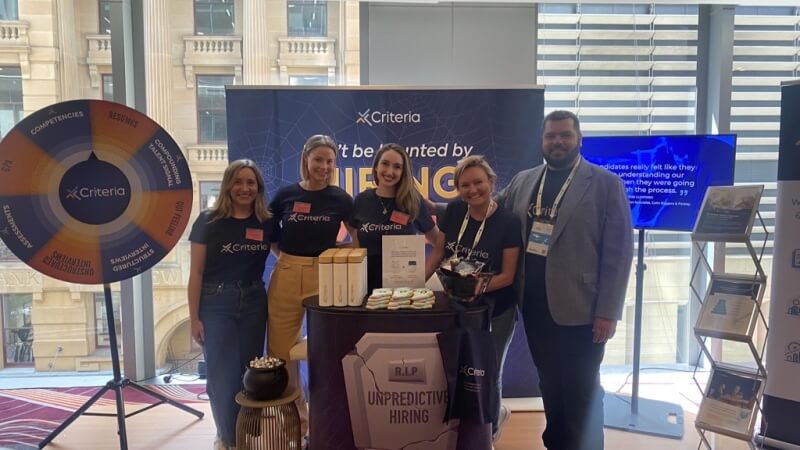Last month, Criteria had the pleasure and excitement of attending the 35th Annual AAGE Graduate Recruitment and Development Conference in Sydney. With the theme of “unconventional pathways, limitless potential,” AAGE challenged attendees to redefine the concept of potential and explore nontraditional ways to attract, engage, select, and retain talent.
We loved personally connecting with each and every one of you who came to say hello and learn about Criteria. We hope you got the chance to SPIN! THE! WHEEL! and win some cool Criteria swag.
During the event, we had invaluable access to industry professionals and thought leaders. We learned a lot, and we are eager to share our most exciting discoveries with you. We were particularly captivated by the wealth of knowledge shared by industry leaders like Zuli Posada and Elyssa Goodman of Atlassian, Sophie Renton from McCrindle, Eric Chau and Dr. Sean Coward of PBC Hogan, Meredith Ward and Dr. Ivonne Ranisch from auticon, and Kate Buchanan of PeopleScout.
And in case you missed it, Criteria’s VP of Global Strategic Alliances Jane Bianchini helped lead the Navigating Pathways and Unleashing Potential panel discussion. Along with her co-panellists, Jane provided tips on how employers can use technology to differentiate their candidate experience from their competitors.
We know effective communication is critical to a positive candidate experience. Jane shared findings from recent research that poor communication is the leading reason candidates abandon the recruitment process. A staggering 54% of candidates walking away due to inadequate communication. Ironically, poor communication is one of the easiest things to fix and fortunately it's an area that organizations have the most control over. Jane spoke to leveraging technology to automate this essential communicate process to help keep candidates engaged and well-informed throughout the hiring journey. It can be as simple as sending an automated email to confirm receipt of their applications, and another to let them know if they are moving to the next stage and what that entails.
In today’s competitive talent landscape, even small improvements in communication can have a significant impact. The way employers communicate with candidates directly influences their level of engagement and their likelihood of accepting an offer.
Candidate experience and sentiment are at the crux of our five key takeaways from AAGE 2023 – let’s dive in!
1. Organizations continue to struggle to keep candidates warm and engaged.
Graduate recruitment poses unique challenges when it comes to keeping candidates engaged throughout the hiring process. With a high volume of candidates lacking work experience, it can be difficult to differentiate between them and even harder to keep their interest. However, we learned several tips to address this struggle.
First, maintaining regular and transparent communication is crucial. Providing timely updates on the status of their application and being responsive to their inquiries helps candidates feel valued and keeps them engaged.
Second, personalisation is key. Tailoring interactions and assessments to individual candidates and their roles demonstrates a genuine interest in their potential and fosters a positive candidate experience.
Finally, leveraging technology solutions can streamline the recruitment process and enhance engagement. Applicant tracking systems and automated communication tools can ensure efficient communication and provide a seamless experience for candidates.
By implementing these strategies, organizations can create a warm and engaging experience for their candidates.
2. Candidates have mixed feelings about AI.
While AI has the potential to streamline and enhance hiring practices, candidate perceptions vary. While AI can offer efficiency and objectivity, graduate candidates typically value the personal touch and interaction that comes with human interaction in the assessment process. They may prefer the opportunity to showcase their skills, experiences, and potential in a more personalised and human-centered manner.
Therefore, it is important for organizations to strike a balance between utilizing AI for efficiency and incorporating human connection to create a positive candidate experience that addresses candidates' desire for personal interaction and connection. In general, consider using AI to help automate some of the “behind the scenes” parts of hiring, while the candidate-facing pieces focus on person-to-person interactions.
Read more about candidate perceptions of AI in our recent blog, AI in Hiring: getting the best from humans and artificial intelligence.
3. Blending live and virtual interactions is essential for a well-rounded recruitment process.
Just as it’s important to ensure a balanced mix between AI and human connection, and the same goes for live and virtual experiences. By combining both approaches, organizations can create a comprehensive and inclusive recruitment process that caters to the diverse needs and preferences of candidates.
Live interactions – like in-person interviews or networking events – provide an opportunity for candidates to showcase their interpersonal skills, build rapport, and establish a personal connection with recruiters and potential colleagues. These interactions can be particularly valuable for some neurodivergent candidates who may thrive in face-to-face settings or require additional support to navigate social situations.
However, virtual interactions have an important place in modern recruitment. Virtual hiring and networking experiences offer flexibility and accessibility, allowing candidates to participate from anywhere, regardless of geographical constraints or personal circumstances. This is especially beneficial for some neurodivergent candidates who may prefer the comfort and familiarity of their own environment. Virtual platforms can also provide features that accommodate specific needs, such as extended preparation times, multiple retakes, or the ability to turn off video or disguise voice. These virtual benefits play a key role in reducing biases and creating a more inclusive environment.
4. The skills gap in graduate recruitment remains a significant challenge for employers.
The disconnect between the skills employers seek and the skills recent graduates possess is a real issue. To help close this gap, organizations can take proactive steps to build a skilled and productive workforce.
When organizations collaborate with educational institutions, they can help ensure that curricula aligns with industry needs and provides relevant technical skills training. To help equip graduates with the necessary skills, organisations should offer in-house training programs to bridge job-relevant skill gaps and provide hands-on experience to new hires.
Implementing pre-employment assessments can help organizations identify candidates with high potential and the ability to learn quickly, regardless of their current skill set. This multipronged approach allows organizations to invest in training and development, closing the skills gap and creating a more skilled and capable workforce.
Check out what the 15 skills of the future are and how you can assess them here!
5. Building strong relationships with universities is essential for employers.
When it comes to bridging the skills gap, a collaboration with universities ensures employers have access to the latest educational insights and enables them to align their recruitment strategies with the evolving needs of the job market. A strong relationship between the two generates a wealth of other benefits too!
Firstly, it allows employers to tap into a pool of talented and qualified candidates. By establishing connections with universities, employers can actively engage with students, create hands-on student experiences, attend career fairs, and participate in campus events. This strategy provides opportunities to identify and attract top talent early on – before the talent has even graduated. This relationship enables employers to build a pipeline of potential candidates and stay ahead in the competitive graduate recruitment landscape.
A strong relationship also fosters a positive employer brand and reputation. Graduates are more likely to be attracted to employers who actively engage with their university and demonstrate a commitment to supporting and investing in their development as future professionals. This involvement can include offering internships, providing guest lectures, sponsoring student projects, or participating in mentorship programs.
By building a positive reputation among universities, employers can enhance their appeal to graduates and position themselves as employers of choice.
---
To recap, here's a summary of our key takeaways:
-
Effective communication is crucial for candidate engagement, and leveraging personalization and technology solutions can help to reduce candidate drop-off.
-
Creating a positive candidate experience that caters to candidates’ desire for personal interaction and connection requires striking a balance between AI and human connection.
-
Blending both live and virtual experiences during the recruitment process is crucial for ensuring equal opportunities for all candidates while also fostering a diverse and inclusive process.
-
Employers have the power to close the skills gap by proactively engaging with universities, offering in-house training, and implementing pre-employment assessments to identify candidates with high potential and fast learning abilities.
-
Maintaining a strong relationship with universities is crucial for employers as it allows them to tap into a pool of talented candidates, stay informed about industry trends and foster a positive employer brand.
That’s a wrap – we look forward to seeing you at our next event!





